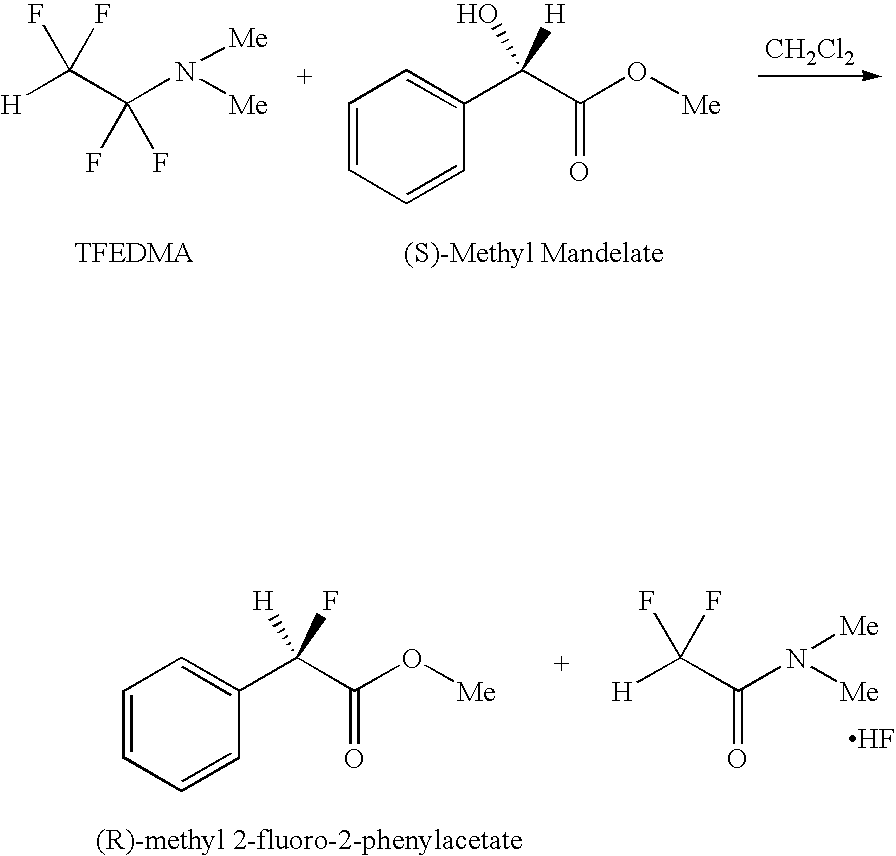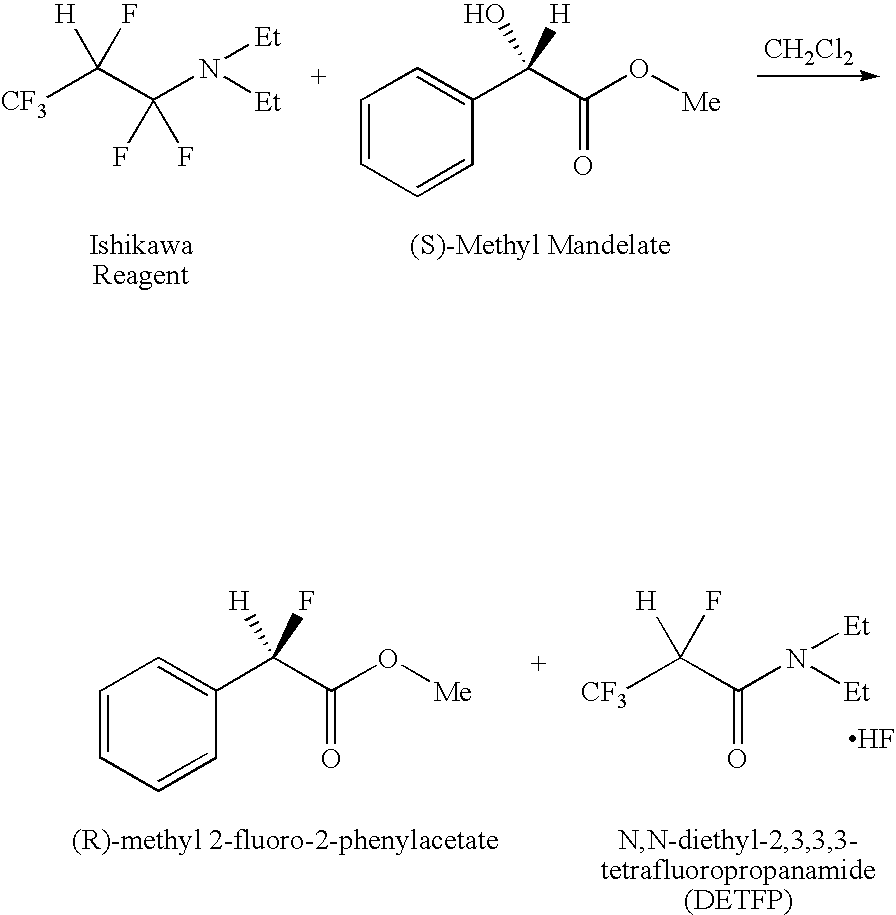Process for fluorination using 1,1,2,2-tetrafluoroethyl-n,n-dimethylamine
a technology of n-dimethylamine and tetrafluoropropyl n, which is applied in the preparation of amino compounds, halogenated hydrocarbon preparations, organic chemistry, etc., can solve the problems of difficult distillation and no convenient method for regenerating n-dimethylamine from the amide byproduct, and achieves good yield, high purity, and good yield
- Summary
- Abstract
- Description
- Claims
- Application Information
AI Technical Summary
Benefits of technology
Problems solved by technology
Method used
Image
Examples
example 1
Reaction of (S)-methyl mandelate with 1,1,2,2-Tetrafluoroethyl-N,N-dimethylamine
[0015]
[0016]This optically active mandelate demonstrates the stereospecificity of the reaction with 1,1,2,2-tetrafluoroethyl-N,N-dimethylamine. 1,1,2,2-tetrafluoroethyl-N,N-dimethylamine (8.5 g, 59 mmol) is added to a 50 mL fluoropolymer (Teflon® PFA) flask equipped with pressure equalized addition funnel. A digital thermometer is inserted and flask the flask cooled under positive N2 pressure in dry ice / acetone bath to −20° C. with magnetic stirring. In a separate flask, (S)-methyl mandelate (Sigma Aldrich, >95%, 6.5 g, 39 mmol) is combined with 50 mL dry CH2Cl2 and 0.5 g MgSO4 to ensure dryness. (S)-methyl mandelate solution is filtered using a 0.45 μm syringe filter into the addition funnel. (S)-methyl mandelate solution is added dropwise to the cooled 1,1,2,2-tetrafluoroethyl-N,N-dimethylamine reagent with stirring. The bath is removed and the solution is allowed to warm to room temperature (RT) and s...
example 2
Reaction of Cyclohexylmethanol with 1,1,2,2-Tetrafluoroethyl-N,N-dimethylamine
[0029]The reaction of Example 1 is repeated with the replacement of methyl mandelate with cyclohexylmethanol (C6H11CH2OH). The desired fluorinated product is cyclohexylmethyl fluoride (C6H11CH2F). The conditions are generally those of Example 1 except that no solvent is used. The product mixture is poured over cold 10% aqueous HCl. An organic and an aqueous phase form. The organic phase is separated. Analysis shows it to be cyclohexylmethyl fluoride of >95% purity. The yield is 75% based on the starting alcohol. N,N-Dimethyl difluoroacetamide is recovered as described in Example 1.
example 3
Conversion of N,N-dimethyl difluoroacetamide to 1,1,2,2-Tetrafluoroethyl-N,N-dimethylamine
[0041]N,N-Dimethyl difluoroacetamide (4.0 g, 32.5 mmol) recovered from the reaction described in Example 1 and dried with molecular sieves, is combined with COF2 (2.6 g, 40 mmol) in a 25 cc volume pressure vessel (shaker tube) and shaken at about room temperature (20-25° C.) for 16 hr. The shaker tube is vented and 4.5 g of liquid is recovered, avoiding exposure to water, such as moist atmosphere. Distillation in a simple microdistillation apparatus gives 4.0 g of 1,1,2,2-tetrafluoroethyl-N,N-dimethylamine, 85% yield based on the starting 4.0 g of N,N-dimethyl difluoroacetamide.
PUM
 Login to View More
Login to View More Abstract
Description
Claims
Application Information
 Login to View More
Login to View More - R&D
- Intellectual Property
- Life Sciences
- Materials
- Tech Scout
- Unparalleled Data Quality
- Higher Quality Content
- 60% Fewer Hallucinations
Browse by: Latest US Patents, China's latest patents, Technical Efficacy Thesaurus, Application Domain, Technology Topic, Popular Technical Reports.
© 2025 PatSnap. All rights reserved.Legal|Privacy policy|Modern Slavery Act Transparency Statement|Sitemap|About US| Contact US: help@patsnap.com


